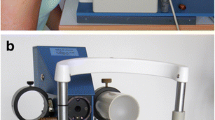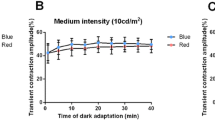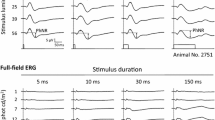Abstract
A c-wave-like cornea-positive potential in the isolated rabbit retina has been described. In this study, frog retinas were investigated to see if the neural retina contributes a slow cornea-positive component to the c-wave of the electroretinogram. The eye cups of both Rana esculenta and Rana temporaria exhibited a normal electroretinogram with c-wave, a larger proximal light-induced extracellular potassium increase, a small distal extracellular potassium increase and an extracellular potassium decrease around photoreceptors. Isolated frog retinas kept receptor side-upward in a moist chamber without perfusion showed the well-known slow PIII generated by the potassium decrease around receptors. If the isolated retinas were well perfused, the slow PIII was not seen, but a cornea-positive d.c. potential sometimes appeared after the b-wave. The different slow potentials seemed to relate to different light-induced potassium changes in the proximal retina. There was a long-lasting proximal potassium increase in the superfused retinas but a quick return of the proximal potassium increase to the baseline in the retinas lacking oxygen at the vitreal side. The lasting proximal potassium increase in adequately maintained retinas may counteract the potassium decrease around receptors and cancel slow PIII.
Similar content being viewed by others
References
Sickel W. Respiratory and electrical response to light stimulation in the retina of the frog. Science 1965; 148: 648–51.
Dettmar P. Electrical responses of the retina elicited by acetylcholine. In: Advances in electrophysiology and pathology of the visual system. Leipzig: Georg Thieme Verlag, 1968: 259–65.
Höhne W. Zur c-Welle im ERG der isolierten Froschnetzhaut. Acta Biol Med Germ 1972; 29: 661–65.
Hanitzsch R. The time course of the light-induced extracellular potassium change around receptors and at the vitreal surface compared with the time course of slow PIII wave in the isolated rabbit retina. Physiol Bohemoslov 1988; 37: 227–33.
Hanitzsch R. Cornea-negative and cornea-positive slow components of the ERG and light induced extracellular potassium changes. In: Haschke W, Speckmann E-J, eds. Slow activity changes in the brain. Boston: Birkhäuser. In press.
Hanitzsch R, Trifonow J. Intraretinal abgeleitete ERG-Komponenten der isolierten Kaninchennetzhaut. Vision Res 1968; 8: 1445–55.
Hanitzsch R, Tomita T, Wagner H. A chamber preserving cellular function of the isolated rabbit retina suited for extracellular and intracellular recordings. Ophthalmol Res 1984; 16: 27–30.
Oakley BII, Green DG. Correlation of light-induced changes in retinal extracellular potassium concentration with c-wave of the electroretinogram. J Neurophysiol 1976; 39: 1117–33.
Karwoski CJ, Proenza LM. Relationship between Müller cell responses, a local transretinal potential and potassium flux. J Neurophysiol 1977; 40: 244–59.
Newman EA. Current source-density analysis of the b-wave of frog retina. J Neurophysiol 1980; 43: 1355–66.
Tomita T, Yanagida T. Origins of the ERG waves. Vision Res 1981; 21: 1703–8.
Steinberg RH, Linsenmeier RA, Griff EA. Retinal pigment epithelial cell contributions to the electroretinogram and electrooculogram. In: Osborne NN, Chader GJ, eds. Progress in retinal research. New York: Pergamon Press, 1985; 4: 33–66.
Newman EA. Distribution of potassium conductance in mammalian Müller (glial) cells: A comparative study. J Neurosci 1987; 7: 2423–32.
Nilsson SEG. Electrophysiological responses related to the pigment epithelium and its interactions with the receptor layer. Neurochemistry 1980; 1: 69–80.
Author information
Authors and Affiliations
Rights and permissions
About this article
Cite this article
Hanitzsch, R., Zeumer, C. & Mättig, WU. The neural retina of the frog contributes a slow cornea-positive potential to the electroretinogram. Doc Ophthalmol 79, 391–397 (1992). https://doi.org/10.1007/BF00160952
Accepted:
Issue Date:
DOI: https://doi.org/10.1007/BF00160952




